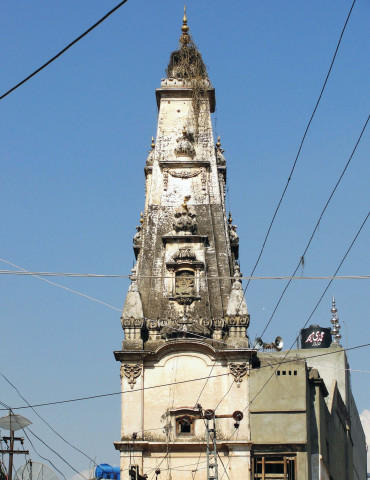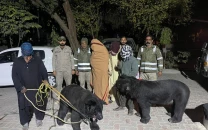Mohan Temple in Lunda Bazaar
Chaudhry Safdar Warraich still roams narrow streets of the old historical locality of Rawalpindi recalling old days.

Mohan Temple in Lunda Bazaar
He knows the history of every old building in the bazaar. According to him, there are three Hindu temples in the locality, a Gurdwara, a Khalsa School and many havelis of Hindus and Sikhs there. Of the three temples, only two survive. The Temple of Kali, which was situated in the main bazaar, no longer exists. It has been converted into living quarters and extensions have been made, thus changing the original structure entirely.
The other temple is situated inside the locality and is not visible from the bazaar. The temple is in very bad state. Its lower part has been turned into living quarters but the beauty of the superstructure or shikhara has survived. The images on the shikhara have not been damaged by either the temple’s residents or the neighbours.
The third temple is situated in the main bazaar. Called Mohan temple, it is a square building. Even the normally octagonal shikara has a square shape. Vegetation has grown over the kalasa (the finial) thus completely camouflaging it. There are four niches on the shikhara carrying the images.
“This temple is believed to have been built by two Hindu Hakims whose names were Hakim Asa Anand and Moti Ram in 1930. Moti Ram was the paternal uncle of Asa Anand. Both ran clinics. Moti Ram’s clinic was situated in Purana Qila and was called Moti Ram DawaKhana, which is now known as Rehmania Dawakhana. Asa Anand’s clinic was situated on Bagh Sardaran road. His havelis was also situated on the same road where his clinic was,” explained Chaudhary Safdar.
Moti Rami’s haveli was located in the bazaar. It was an imposing double storey building with beautiful doors and window and continues to dominate the bazaar’s landscape. According to Chaudhry Safdar, about 300 bags of Dal Mash were used in the construction of the temple. The Dal was put in the water at night and was ground in the day to make paste which was applied on the outer and inner surface of the temple, a forgotten technique that was then very common.
There were two images in the temple, one of Devi and another of Devata. From the images carved in the shikhara, it appears that the temple was dedicated to Shiva and Parvati. One of the images on the Shikara is that of Ganpati (Ganesh), Shiva’s son. On the basis of the images, one can say that temple was dedicated to Shiva.
The image of the Ganpati has four arms holding four objects in the hands. His mount (vihana) mouse is also carved on the left leg.
Today, a Muslim family inhabits the temple. According to Muhammad Nafees, whose hotel is located near the temple, Moti Ram’s daughter visited the temple and the haveli six months ago. Tears rolled down her cheeks when she saw the buildings in which she spent her childhood days.
People living in the temple and havelis of the Sikhs and Hindus have not damaged them. One can still see paintings on the temple’s entrance gate. The inscriptions bearing the names of the Hindus are still there. The concerned authorities should document all the inscriptions found on the temples, gurdwaras, dharmsalas and havelis of Hindus and Sikhs before they are lost for good.
The Author is Research Anthropologist at Pakistan Institute of Developments Economics (PIDE), Islamabad. He may be contacted at zulfiqar.kalhoro@tribune.com.pk
Published in The Express Tribune, March 4th, 2011.



















COMMENTS
Comments are moderated and generally will be posted if they are on-topic and not abusive.
For more information, please see our Comments FAQ